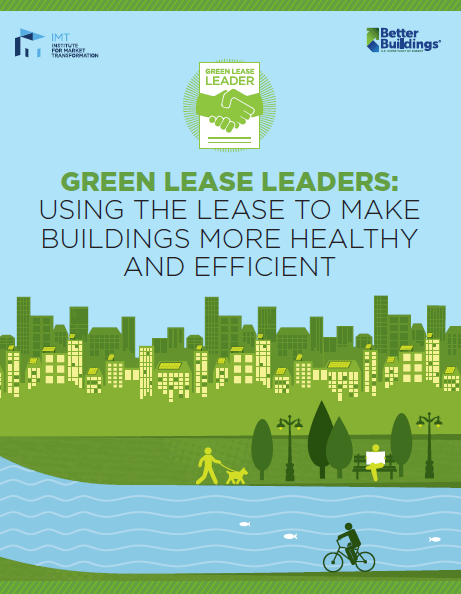With a green, high-performance lease, landlords and tenants can better work together to save billions of dollars and lock in smarter, more efficient operation of buildings. Since its inception in 2014, IMT and the U.S. Department of Energy’s (DOE) Better Buildings Alliance’ Green Lease Leaders recognition program has grown to include firms that represent more than 1.8 billion square feet of building space—a clear indication that green leasing is no longer considered an exception, rather it is becoming best practice across real estate markets.
As building efficiency efforts have progressed to more advanced holistic approaches, green leases have evolved as well. The 2018 cohort of Green Lease Leaders are using the lease to not only overcome split incentives but also drive innovation and adoption of forward-thinking strategies that create value. As part two of a new three-part case study series, IMT and DOE’s Better Buildings Alliance are shining a spotlight on 2018’s Green Lease Leader designees that are using strategies to incorporate health and wellness into their green leases and overall operations. In each case study, leading sustainability professionals share their organization’s best practices that every real estate or sustainability practitioner should consider when leasing property.
Read Green Lease Leaders: Using the Lease to Make Buildings More Healthy and Efficient to learn about:
- Federal Realty Investment Trust’s lease requirements for preventive maintenance, integration of pest management and green cleaning programs, and its use of a rooftop farm to grow healthy food while yielding other sustainability benefits.
- Ivanhoé Cambridge’s lease requirements to ensure good indoor air quality, use of non-toxic products, and its provision of bike racks and electric vehicle charging stations at properties to encourage healthy and environmentally-friendly transportation.
- TD Bank’s integration of its updated energy management plan into lease agreements and its collaboration with landlords to provide employees with health and wellness-focused amenities such as a professional-grade gym and shuttle bus service for employees.
- The Tower Companies’ efforts to earn the first ever Fitwel health and wellness certification for a multifamily residential building while incorporated green building guidelines and requirements into its residential lease.
This resource is part two of a series to showcase exciting green lease trends and stories about the Green Lease Leaders that are driving them.
- Read part one to learn how Green Lease Leaders are using the lease to drive innovation and clean energy.
- Read part three to learn how Green Lease Leaders are galvanizing landlord-tenant engagement that leads to higher performing buildings.
- Visit greenleaseleaders.com/resources for more on how Green Lease Leaders are using the lease to catalyze high performance in buildings.
Become a Green Lease Leader
If you are a tenant encouraging your landlord to collaborate on sustainability goals, or if you’re a landlord working closely with tenants to make their space more efficient and healthy, you might be a candidate for IMT and DOE’s Green Lease Leaders recognition.
A first step is to assess your lease and corporate documentation in comparison to the standards specified by the Green Lease Leaders recognition program. Even if you are not currently including energy efficiency and sustainability in your lease, but practice sustainability in building operations and management, the Green Lease Leaders criteria can serve as a guide for enhancing a lease to account for sustainability.
For more information on Green Lease Leaders, or for help in building your own green lease, visit the Green Lease Leaders website to learn more about the program and how to apply for recognition at greenleaseleaders.com/apply or contact IMT at imtweb@imt.org.
